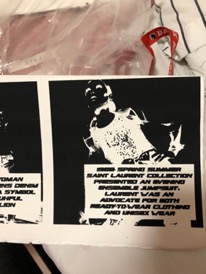By Ash Prather
The jumpsuit is an important garment in the evolution of both unisex and youth culture. Not only was it used during World War II to allow women to participate in the workforce, but it was also redesigned to accommodate the Space Age fashion in the 1960s. For my final project, I hope to bring to light the history that the jumpsuit contains through the silkscreen artwork that I have created.
According to fashion scholar, Jo Jenkinson, unisex has been a conduit for radical change since World War II. When men went to the front lines, American women joined the workforce en masse for the first time. However, the existing style for feminine clothing–long, flowy dresses–would result in numerous accidents in factories. Changes had to be made.
In 1942, designer Vera Maxwell was commissioned by Allis Chalmers and Sperry Gyroscope Co. to design a jumpsuit for female factory workers (as depicted in the famous Rosie the Riveter poster). Later, around 1957, silver metallic fabric, make-up, and jewelry became the staple for a new movement, Space Age fashion. At this time, the jumpsuit was also used because of its heavy resemblance to the suits worn by astronauts. These are both perfect examples of what Anne Hollander meant in her book Seeing Through Clothes when stating “the style is what combines the clothes and the body into the accepted contemporary look.” In the 1940s, the accepted look slowly became women wearing clothes that weren’t long and flowy. The style of the jumpsuit created an acceptable new look for women, as Hollander previously stated. During the Space Age, the new metallic look merged the innovative stages of NASA/Space Race with that of the fashion world. For my final project, my main goal is to encapsulate visuals from these two periods of time, as well as the information I discovered in my research.

When I first began this project, I was unsure of how to approach the final piece. I didn’t know if the best plan was written and informative, visual, or a combination of the three. It seemed counterintuitive to disregard the information I found entirely by creating a full jumpsuit, or some form of miniature variant. So, after painstakingly changing my idea, my conclusion was to incorporate my silkscreen class knowledge with the visual and descriptive knowledge on the jumpsuit.
In terms of execution, I found images related to the jumpsuit from World War II and the Space Age, inverting them, layered in text about the jumpsuit, and printed the result on paper using a silkscreen technique. My goal is to give the viewer a deeper insight into the garment’s history. The panels/images I selected were based around major points in the jumpsuits’ history, and overall facts that stood out to me during the research part of my project. This final product will be an accordion print on one sheet of Arches 88 paper, folded it in a way that reveals one image at a time. (This idea could further develop to be a sequence or storyline in terms of the jumpsuits’ history). If opening the accordion, and looking from left to right, the viewer can experience a visual timeline of the jumpsuits’ development.
A major challenge I had when doing the first couple passes in silkscreen was that the text was somewhat unreadable, as there was more ink going through the screen than I wanted. To fix this problem, I simply used a less dense squeegee when putting the ink through the screen, and doing the print on newsprint until the amount of ink and the overall image I wanted was at its most refined. In terms of a design challenge I had to face, my main struggle was deciding what aspects of the jumpsuits history to convey, and the best medium I felt to convey it. In order to solve this problem, I looked at the resources given to me. My decision to use silkscreen to convey the depth of the jumpsuit was mainly based on the eye-catching value the technique can convey. Through distortions of photographs and scans related to the jumpsuit, silkscreen can draw the viewer in, and raise questions about what is being shown. My main focus was to bring attention to my piece, and enlight the viewer on what elements of my garment I discovered through research.





